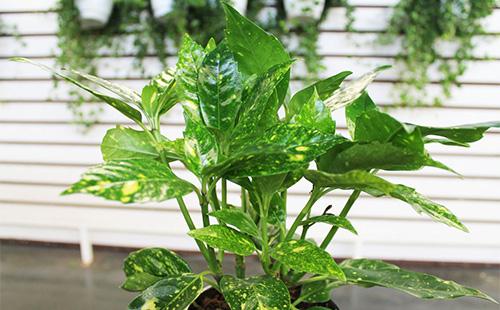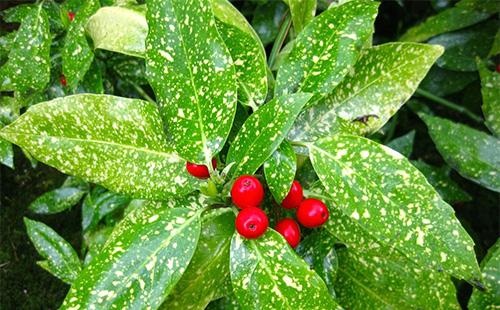The content of the article
In translation, the name of the plant sounds like "always green." Foliage retains decorativeness all year round. Fancy yellow spots on foliage are often compared to the glare of the sun and gold nuggets. For this, the Aucuba was nicknamed the Golden Tree.
How she looks like
It grows in the form of a volumetric shrub or low tree. In nature, it can stretch up to four meters, height in artificial conditions - one and a half to two meters. Branches are highly branched. The bark is dark green in color, smooth, often with brownish or red stains. The lower leaves fall over time, traces of them remain on the trunk.
The leaves are fastened with petioles, oblong, dark, with various spots and patterns of yellow color. Fold along the main vein is characteristic. The edges of the leaves are uneven, serrate. In nature, flowering begins at the very beginning of spring. The apartment practically does not bloom. Paniculate or raceme inflorescences are located on the tops of shoots.
Varieties in room culture
Aucuba is not diverse. Only three types of plants are known. Only two of them are suitable for growing in a room. But on the basis of these species, breeders have developed several interesting varieties with enhanced decorative qualities.
- Aucuba Himalayan. Not too common in culture. Leaves of pure green color, elongated, oblong. At the tip of the leaves there is a slight sharpening. The edges are serrated or solid.
- Aucuba is Japanese. The main variety for home growing. The stems are lignified, green. The leaves are leathery, elongated-oval, located opposite to the stem. The edges of the leaves are serrated. Based on the species, several hybrid varieties with a different arrangement and size of yellow spots were bred.
Features of caring for aububa Japanese
If you know all the features of caring for aukuba Japanese, you can avoid most diseases. In general, this is not a capricious, easy-to-grow plant. Provided that a number of recommendations from experienced gardeners with its cultivation are observed, there are no problems even for beginners.
- Lighting. Create diffuse but bright lighting. They do not set in the open sun - burns quickly appear on the leaves, a characteristic golden pattern is smoothed out. It tolerates light partial shade, but stretches in a strong shadow, loses decorativeness. In winter, organize additional lighting - aucube needs a long daylight hours.
- Temperature. Maintain neutral temperatures in the range of 19-20 ° C. It does not tolerate heat - it provokes rapid aging and falling of leaves.In summer they rearrange it on the street, but they protect it from precipitation and the open sun. In winter, you need coolness - not more than 14 ° С. Cooling below 5 ° C is not allowed. If it is impossible to organize a cold wintering, the flower is regularly sprayed, set under fluorescent lamps.
- Watering. Watering is recommended immediately after drying of the top layer of the substrate. It is watered abundantly in summer, and in moderation in cool time. Drying is easier than excess moisture. In constant dampness, Japanese Aucuba leaves turn black.
- Humidity. Neutral to dry air. Spraying is necessary in winter with a warm wintering and in summer in extreme heat. A plant wintering in a cool room is not sprayed - the combination of moisture and cold provokes the development of fungal diseases.
- The soil. The soil is needed light, loose. The simplest composition is equal amounts of leaf soil and turf. Sand is added as a baking powder. Be sure to provide a drainage layer.
- Top dressing. Fertilizers are applied in the spring and summer. Intervals between feeding - a week. Mineral complexes are often added, sometimes it is possible to feed with organics.
- Transfer. If there is not enough space for the roots, it will be correct to transplant the aucuba into another pot. Adult plants are usually transplanted at least once every two years. Young, intensively growing specimens are transplanted annually. The roots are brittle, brittle - transplant very carefully. It is better not to disturb the root system - transplant by transshipment. The day before the transplant, the aucuba must be watered. The pot is chosen wide and not very high.
Cropping Basics
In early spring, even before the signs of active growth, it is recommended to trim the aucuba. The overgrown shoots are cut off, giving the bush a neat shape. Pruning stimulates branching, growth of lateral shoots, forms a lush crown.
In young specimens, new shoots are nipped. Aucuba is a fast growing crop. The average growth per year is up to 20 cm. Without pruning, the shrub quickly grows to large sizes, it turns shapeless.
Aucub pruning perceives well. Long, elongated shoots are cut annually by a third. Straight branches pinch or prune to stimulate lateral branching. Branches directed inside the bush, diseased and dried shoots are removed.
How to propagate
Growing aucuba in a pot at home requires periodic replacement of the plant. In the absence of proper formation and simply because of age, the lower part of the branches is gradually exposed. It is better to think in time about growing a new plant to replace the old one. There are only two methods of reproduction.
Seeds
Seed propagation is a complex process. Seeds lose their germination very quickly, so they are usually sown immediately after harvest. But since it is almost impossible to get them at home, one has to rely on the germination of store seeds. It is better to sow with a margin - only a small part can emerge.
Sow the seeds in a peat-sand mixture, top cover with glass or film. The temperature during the germination period of aucuba seeds is maintained moderate - about 21-22 ° C. Remove the glass daily, ventilate the greenhouse, and if necessary, spray the soil.
With the advent of shoots, shelter is removed. The grown aucuba seedlings can be planted in separate containers. At first, they adhere to a gentle care regimen, they gradually accustom them to bright light and heavy watering.

Cuttings
It is much easier to propagate aucuba with cuttings in water or in the ground. In reviews and on forums, there is information that in aucuba water takes root longer, but in the future the plant develops faster.
Cuttings are cut in early spring or closer to autumn. At least two leaves are left on each handle. The lower section can be treated with the preparation “Heteroauxin” or “Kornevin” to accelerate the appearance of roots.
Treated cuttings are placed in a glass of water with the addition of a tablet of activated carbon or immediately instilled into light soil. When rooting in the ground, shelter made of polyethylene or glass is used. In both cases, the temperature is maintained at 22 ° C.
After the appearance of the roots, the cuttings are transplanted into separate small pots. Young plants are provided with thorough care until stable signs of growth appear. Then it is gradually rebuilt to standard care, as for adult plants.
Growing difficulties
Aucuba is an exotic plant. For good growth, maintaining decorativeness, he needs the right microclimate, balanced care. If the conditions of detention are violated, a number of problems may arise. The most common consequences of care errors are listed in the table.
Table - Difficulties in growing aucubas
| A problem | Possible reasons |
|---|---|
| Leaves fall | - low humidity; - heat |
| Leaves turn pale | - Too bright lighting; - sunny place |
| Young leaves are crumbling | - lack of nutrients |
| Yellowing and falling of the lower leaves | - Natural process; - unsystematic watering; - sharp temperature changes |
| Drying the ends and edges of the leaves | - Bright lighting; - drying of the earth in the summer; - dry air in the winter season |
| Black spots on foliage | - Wintering in the warmth; - dry air |

Aucuba Pests
Many problems are caused by pests. The aucuba is especially often attacked by a spider mite, scab, mealybugthrips andwhitefly. They fight with them in approximately the same way - they mechanically remove insects with an alcoholized cotton swab and treat the plant with insecticides. More signs of pest damage are shown in the table.
Table - Aucuba Pests
| Insect name | Signs of defeat |
|---|---|
| Spider mite | - Thin spider web on the back of the leaves; - yellowing, drying of the leaves; - small bright points on the outside of the sheet |
| Mealybug | - Aucuba withering; - the formation of lumps of "wool" in the axils of the leaves |
| Thrips | - The appearance of small bright spots on the outside of the sheet, brown - on the inside; - Aucuba leaves seem silvery; - yellowing, drying and falling of leaves |
| Shield | - Insects are visible to the naked eye in the form of brown plaques on the stems; - the appearance of sticky drops; - wilting plants |
| Whitefly | - Small white flying insects over a flower; - sticky discharge on the leaves; - drying and falling of leaves |
Knowing and understanding how to care for aukuba Japanese, you can avoid most of the problems described. This is a very beautiful long-lived plant, which for many years will delight you with its unusual decorative foliage.

